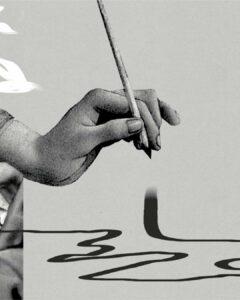
“I have cultivated in myself a sixth sense, an ‘Ararat’ sense:
the sense of attraction to a mountain.”
Osip Mandelstam[1]
The Third Republic of Armenia is in a precarious geopolitical situation. Its strained relations with its eastern neighbor, under a “re-elected” dictator, is a constant reminder how tenuous the discussions about lasting peace in the region are. War may be looming again, and in the best-case scenario there will be a prolonged period of uncertainty, rather than actual peace. Armenia’s domestic political situation is conditioned by its external one –– uncertainty over the current constitution, the declaration of independence, and even the country’s coat of arms. Adding to these potential changes, Armenian Prime Minister Nikol Pashinyan initiated a somewhat peculiar discourse about the state and fatherland, saying: “All of our problems are between Ararat and Aragats.”[2] It is time to scrutinize this discourse critically and briefly explore the potential issues it may generate.
Pashinyan has been grappling with the issue of a “new model of patriotism” for nearly a year. As he sees it, we must choose between reality and dreams, between fatherland and state. To contextualize the two concepts we should elicit their meaning from Pashinyan’s discourse. The Prime Minister suggests that Armenians’ territorial understanding of their fatherland does not align with the current borders of the republic. He claims that Armenians’ patriotism, their love for the fatherland, conflicts with the idea of Armenian statehood.[3] Hence, he posits, this needs to change because the fatherland Armenians envisage is more of a dream than reality. The reality is the current Armenian state with its internationally recognized borders.
At first glance,the Prime Minister’s point may seem valid. After all, Armenians do approach history with a sense of hopefulness as to the imminence of historical justice that should undo all their suffering and reinstate their fatherland to its former size and greatness. However, upon closer scrutiny, Pashinyan’s argument falls apart. In a typically Pashinyanesque way, he simplifies the discourse into a choice between two mountains: Ararat and Aragats. Pashinyan glibly suggests that choosing between these two is the first step towards appreciating the current Armenian state. In other words, we should relinquish the dreams of a lost fatherland and embrace the reality that is the current republic. He portrays Mount Ararat as the symbol of the nation’s atavistic longings and the dream of a “sea to sea Armenia” while Aragats symbolizes the state.
Pashinyan’s whole discourse runs astray with the introduction of the opposition between Ararat and Aragats. A discerning reader might question how choosing between two mountains determines one’s state-centrism or our anti-statism. To put it succinctly, while Pashinyan points out the problem correctly, i.e. Armenians’ unrealistic political aspirations, he fails to propose an effective solution. He suggests Armenians should accept reality and choose the Armenian state over their idealized fatherland. His method includes diverting the nation’s deference and love for Mount Ararat towards mount Aragats. He implies that if Armenians love the mountain that they have as opposed to the mountain they have lost, they will become more realistic, less fanciful, and, in his mind, state-centric. In other words, they will favor the Armenian state over their dreams of a lost fatherland.
The time has come to understand that neither our mountains, nor our stones, and trees define our state. Whether Armenians love Aragats or Ararat, the oak tree or the apricot tree has no bearing whatsoever on our perception of the Armenian state. A well-functioning state does not need an overly zealous following, lest we want to slip into Fascism. It needs citizens who harbor no irrational fears, and are able to reform it through participation and criticism while not feeling alienated from it. By propounding the aforementioned discourse Pashinyan does the exact opposite and makes sure that Armenians in and outside of Armenia become estranged from the Armenian state even more. What is more, he risks a significant backlash from the public, who might cling to their dreams even more steadfastly than before.
Pashinyan’s attempt to placate Erdogan and Aliyev risks alienating his own population. Their support is crucial for Armenia to overcome the current dire situation it finds itself in. Moreover, his flimsy argument to persuade the nation that it’s time to seek new national symbols only adds insult to injury. In the past three years, Armenia has suffered more losses than it could afford, partly due to the myopic politics pursued by Pashinyan himself. This includes his bold statement “Artsakh is Armenia, period,” and his failure to address Armenia’s military and economic overdependence on Russia. We lost the war in 2020, along with some 4000 soldiers, most of whom were young men. Artsakh has been ethnically cleansed and Azerbaijan occupies parts of Armenian territory.
Having pointed out the fallacies in Pashinyan’s argument, we must also explore potential solutions to the problems identified by the Prime Minister. Critical questions must be addressed: What has the Armenian state done for those living below the poverty line?[4] Are there state programs aimed at improving their situation? In 2023, there were plans to introduce national health insurance, a step in the right direction, but only a start.[5] To gain public acceptance, the Armenian state must become more socially and welfare-focused. Most Armenians still perceive the state as a mere coercive entity. Therefore, Pashinyan’s administration, or any future Armenian government, should move beyond abstract discussions and confront reality by taking steps to reform the state and address the social and economic issues facing the Armenian people, instead of simply urging them to accept their reality.[6] Perhaps if the economic and socio-political circumstances weren’t so severe, Armenians would not feel compelled to escape into dreams.
As much as it is a bureaucratic machinery, a state is a concept and an idea. What gives a nation-state its essence is the identity of the nation it represents –– an identity ever-changing and yet consistent over time. Ararat, described by Charents as an “unattainable path to glory” (անհաս փառքի ճամփա), might be eternally lost, but it is a fundamental part of Armenian identity. And one cannot overlook the mountain’s historical significance in both pagan and Christian eras.[7] Mount Ararat doesn’t hinder us from building a functional state, and suddenly loving Aragats will not help us achieve our goals. What we need instead are concrete plans and state-initiated programs that can improve the lives of an already suffering nation. It is time to pause and ask, “Quo vadis, Armenia?” before we jettison our national symbols en masse.
* The title is inspired by Charles Dickens’ novel A Tale of Two Cities.
Footnotes:
[1] Journey to Armenia, Memmingen 2011, p. 99.
[2] The short video essay on this subject by Azatutyun is most informative: «Արարատի և Արագածի արանքում».
[3] See the following speech delivered by Pashinyan at the Armenian Parliament, especially from minute 7 onwards: https://www.youtube.com/watch?v=WhCoGkdGAIw.
[4] According to state statistics some 24.8% (by average poverty line) to 41.3% (by upper poverty line) of the population lives below the poverty line.
[5] Narine Ghalenchian: Armenia Gears Up For National Health Insurance, 2023.
[6] Thus, far the only institution that has been undergoing serious reforms is the army and this only after the catastrophic failure of 2020.
[7] There are coins minted by the Artaxiad dynasty which on the reverse face carry the image of Ararat, unique symbolism that imparts a sense of deference towards the mountain. The Christian tradition, which we are part of, turned Ararat into a Biblical mountain, Noah’s ark rested on it, and further accentuated its centrality in Armenian history.
Recently published
Daniel Dznuni: The Interrupted Flight, Part 2
Armenia’s first and only cinema mogul, Daniel Dznuni, was accused of sabotaging the work of Armenfilm in 1936. After spending several years in prison, he was released but never returned to the theater. Part II of Anush Vardanyan’s exploration of Dznuni’s life and work.
Read moreBehind the Wheel: Fatal Car Accidents On the Rise
Armenia has one of the highest rates of automobile deaths among all European Union and former Soviet countries. Despite calls for improving road safety in the country, traffic-related fatalities have increased over the past decade.
Read moreCan the West Be a Reliable Partner of Armenia? Part II
In Part II of a two-part series examining Armenia’s pivot to the West, Gaidz Minassian examines the question of the reliability of the partnership with Americans and Europeans.
Read more




I am surprised and very disappointed that the PM of Armenia is leading the people down a garden path that will cause many more problems than it solves.
I fully understand Armenia’s predicament. Armenia made a bad bet with Russia for the past 25 years and Russia sold its ally because it had more to gain with Azerbaijan and Turkey. This also happened in 1920 and so I don’t understand why Presidents Kocharyan and Sargsyan repeated the same mistakes. Now Armenia’s military is underequipped and is not able to resist Azeri aggression. So Pashinyan has opted for appeasement, ceding territory and not responding militarily to many violations of Armenia’s sovereign borders. Part of the appeasement is changing Armenia’s constitution, national symbols and rewriting textbooks. By doing that he will further divide an already divided Armenian nation between Armenia and diaspora. Instead Pashinyan should be putting all his energies in uniting ALL Armenians to resist annihilation. Why not inspire the people in Armenia and Diaspora to RESIST? Why not organize financial networks ( Armenia Bonds for example) so that people can contribute ? Why not encourage Armenian organization to work closely with the government? So much can be done to inspire and resist. Instead we hear the pathetic drumbeat of “peace” when soldiers are dying on the front.
So well said